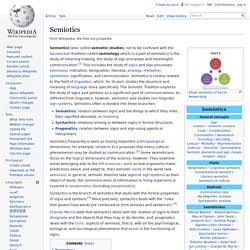

Signs. Daniel Chandler Signs We seem as a species to be driven by a desire to make meanings : above all, we are surely - meaning-makers. Distinctively, we make meanings through our creation and interpretation of 'signs'. Indeed, according to Peirce, 'we think only in signs' (Peirce 1931-58, 2.302) . Signs take the form of words, images , sounds, odours, flavours, acts or objects, but such things have no intrinsic meaning and become signs only when we invest them with meaning. The two dominant models of what constitutes a sign are those of the linguist Ferdinand de Saussure and the philosopher Charles Sanders Peirce. Saussure offered a 'dyadic' or two-part model of the sign.
A 'signifier' ( ) - the which the sign takes; and the 'signified' ( ) - the it represents. The is the whole that results from the association of the signifier with the signified ( Saussure 1983, 67 ; Saussure 1974, 67 ). A : the word ; a : that the shop is open for business. Semiotics. Semiotics frequently is seen as having important anthropological dimensions; for example, Umberto Eco proposes that every cultural phenomenon may be studied as communication.[2] Some semioticians focus on the logical dimensions of the science, however.

They examine areas belonging also to the life sciences – such as how organisms make predictions about, and adapt to, their semiotic niche in the world (see semiosis). In general, semiotic theories take signs or sign systems as their object of study: the communication of information in living organisms is covered in biosemiotics (including zoosemiotics). Syntactics is the branch of semiotics that deals with the formal properties of signs and symbols.[3] More precisely, syntactics deals with the "rules that govern how words are combined to form phrases and sentences".[4] Terminology[edit] Ferdinand de Saussure, however, founded his semiotics, which he called semiology, in the social sciences: History[edit] Formulations[edit] Branches[edit] Notes. Outline of semiotics. The following outline is provided as an overview of and topical guide to semiotics: Semiotics – study of meaning-making, signs and sign processes (semiosis), indication, designation, likeness, analogy, metaphor, symbolism, signification, and communication.

Semiotics is closely related to the field of linguistics, which, for its part, studies the structure and meaning of language more specifically. Also called semiotic studies, or semiology (in the Saussurean tradition). What type of thing is semiotics? [edit] Semiotics can be described as all of the following: Academic discipline – branch of knowledge that is taught and researched at the college or university level. Branches of semiotics[edit] Three main branches[edit] Subfields[edit] History of semiotics[edit] Methods of semiotics[edit] Semiotic analyses[edit] General semiotics concepts[edit]
Icons, Symbols and a Semiotic Web. – October 15th, 2005 – Semiotics, loosly speaking, is the study of signs.
Simple enough. What becomes difficult is defining what a ‘sign’ actually is. When we think of signs we think of the things on the left there don’t we? We think of something visual like a signpost. What this article isn’t about This article is not about semiotics. Starting at the beginning We’ve established that semiotics is the study of signs, and signs can be made up of all sorts of stuff like language, pictures, body language etc. but what does all this mean in a practical sense? Modern day Semioticians, not only study ‘signs’ - it goes much deeper than that - they study how meaning is formed. There are three main areas of semiotics; the signs themselves, the way they are organised into systems and the context in which they appear. We’ll have a look at the first of these in this article. The Signs themselves Charles Sanders Peirce is an American philosopher recognised as the founder of modern semiotics.
THE SEMIOTICS OF THE WEB.